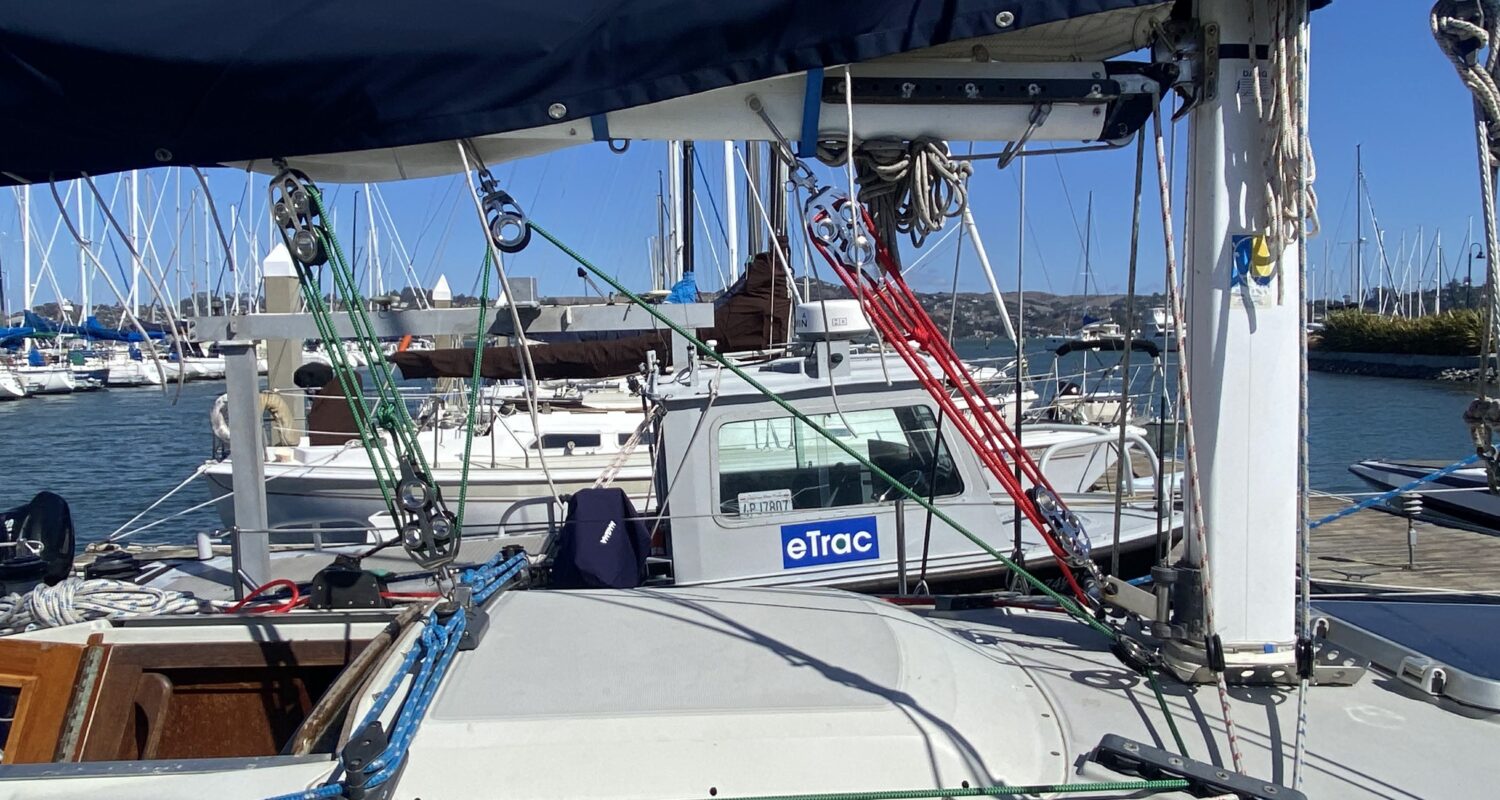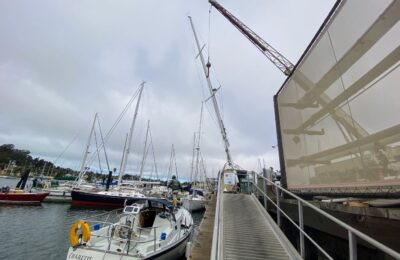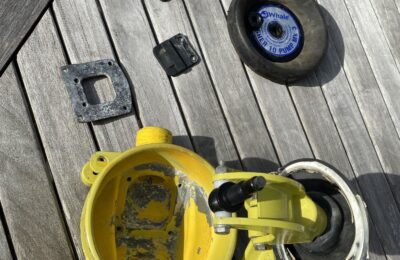TLDR: I replaced and subtly reconfigured the lines for my mainsheet and boom vang, as well as replacing almost all of the blocks on my deck. Doing so makes the boat more fun to sail. Total budget @$900, of which the majority was new Garhauer hardware.
Introduction
When I bought my boat, the selling broker suggested that I take off the lines and wash them with fabric softener. This seemed like a good idea, so I did just that and the lines felt fine – better – whatever, but I didn’t have much context for what a sail control line should feel like. Adjusting the lines on the boats we used for my ASA Sailing classes lessons, was terrible. Several days we sailed a C&C 30 or 31 or something and cranking in the main sheet pre-gybe was miserable.
It doesn’t have to be so bad. After working in several areas of sail controls, my boat is now much more pleasant to work with.
Mainsheet Revision
A brief digression for the uninitiated: The mainsheet is the rope that controls the position of the boom of the mainsail relative to the direction of the wind. There is a second device called a traveler, connected to the main sheet blocks (pulleys) that also helps to keep the boom positioned side-to-side where the sailor intends.
There are several ways to locate the traveler and mainsheet in a sailboat.
Transom-mounted traveller & mainsheet
A simple method is to put the ropes at the trailing tip of the boom. This would have the traveler mounted on the transom, at the back edge of the boat. Small racing dinghies are frequently rigged this way. (In the picture below, the red rope connects to the rear tip of the boom).
The advantage of this position is that the guy pulling the rope has a lot of leverage over the strength of the wind because the attachment point at the end of the boom means it is at the end of a long lever. A disadvantage is that a long line must be used to accommodate the swing of the radius tip of the boom. A second disadvantage for a typical cruising sailboat is that the traveler and mainsheet lines would obstruct much of the cockpit. In my Ericson 32-200 the sheets would interfere with steering.
Bridgedeck Traveler
An alternative to the stern transom-mount is to move the traveller and mainsheet one step forward in the boat and mount them on the “bridge deck.” “Bridge Deck” is quite a nautical way of describing the bench seat in front of the cabin entrance (companionway).
The advantage of this arrangement is the ease of access to the ropes while in the cockpit, and a connection point that is fairly far aft/back on the boom to provide adequate leverage to pull against the wind. The disadvantages of the bridgedeck mount is that access to the cabin is now made difficult by the placement of the lines, and the traveller itself becomes a tripping hazard on the way in and out of the cabin.
Cabintop Mid-Boom Sheeting
A common arrangement for cruising boats like mine is to place the traveler on top of the cabin, forward of the companionway, and to connect the line to the middle of the boom, (hence mid-boom sheeting). Access to the companionway is kept clear, and it is possible to have dodger installed aft of the sheets.
The disadvantage of this arrangement is that as the connection point on the boom moves forward, more force must be used to pull on the ropes to move the boom up into the wind. The problem is exacerbated in the design of my 32-200 which has a “recessed companionway” wherein the companionway is moved forward, leaving even less room between the mainsheet connection on the boom and the mast. It means pulling on a short lever.
My inherited mainsheet rigging looked like this:
In order to get more pull or leverage I wanted to consolidate the rear and middle sheaves (pulleys) on the rearmost mount to make moving the boom easier.
Harken, a maker of sailing accessories, has a mainsheet loading calculator with which one can input some dimensions of his mainsail and boom and to calculate how much force will be required to move the sail. I played with it a little bit, but ultimately decided that I wasn’t planning to drill new holes in my boom so I should try a rig with new lines and hardware.
In a thread on the Ericson Yachts forum, I found a helpful discussion from other owners who have addressed similar problems.
Ropes/Lines
I bought ⅜” nominal New England Ropes Sta-Set double-braid from defender.com. It was $0.80 per foot. I think my old rope might have been 7/16” wide, or possibly just salty and swollen 3/8ths. The trade-off with the diameter of the line is that fat lines are easier in the hand, but run through sheaves less easily. New rope is lovely and supple.
I thought I would put eye splices in the double-braid for elegance and neatness. I had eye-spliced a lot of single-braid dyneema for my lifelines. How hard could double braid be? I already had a set of fids for splicing.
It turns out, putting an eye splice in a double braid line is a huge pain in the rear. I tried multiple times and kept losing part of the rope from the fid, etc. etc. Defender charges $19 to put an eye splice in a double-braid line of this diameter. I would make this choice in the future for sure and save myself some frustration. I tied bowlines instead.
Blocks/Pulleys
My boat came with what I think are original Lewmar sheaves from 1990. I am sure they were top shelf at the time. They are solid plastic (delrin?) sheaves that encircle stainless steel axles.
New school blocks have ball bearings to decrease friction. It’s all ball bearings these days. All of the major manufacturers (Harken, Schaeffer, Lewmar, Ronstan) make a version of this type. After positive reviews of the manufacturer from other Ericson owners, (as well as a tacit endorsement one from my Youtube sailing heros, Sam Holmes) I chose Garhauer blocks.
I purchased the Garhauer items from Whale Point Marine/Ace Hardware in Point Richmond California. Ask for Jay. The turn-around time on orders from Garhauer is not great (2-3 weeks) but you may be able to get a decent break from MSRP if you are nice and order several items at one time through Whale Point.
For the opposing fiddle blocks for the main and vang, I purchased the Garhauer 40 series blocks. These are somewhat larger than the Lewmar fiddle blocks I was replacing, but the size relates to the minimum diameter of the smaller of the two sheaves in the fiddle block. If one chooses a smaller Garhauer 30 series, the lines will rub on one another if two fiddle blocks are set directly opposite one another, as in my implementations.
At the same time I replaced my mainsheet and blocks I replaced my boom vang and accompanying blocks. The inherited vang set up was like the mainsheet, composed of salty line and experienced Lewmar blocks.
The new line and block configuration looks like this:
The new fresh 3/8th” line and the new ball bearing blocks make a huge difference in the ease of use of the mainsheet. The slippery quality of the line does mean that one needs to put 3 turns on the cabin top winch in to get adequate friction if winching is necessary, but I have found that with the lighter lines, and better blocks I am able to adjust the boom position manually much easier than with the set-up I had before. I need to use the winch on the mainsheet less frequently.
I also replaced the turning blocks around the base of my mast that serve the halyards, reefing lines, and allow the vang and mainsheet to be led to the cockpit. When I climb up the mast using my Mastclimber, I rely on the main halyard and related tackle for my safety. If that halyard goes through a dainty block and it or the shackle snapped, I could fall and hurt myself. Hence, I purchased a turning block with a very generously-sized shackle for a margin of error when I am hoisting myself with my own petard.
I also continued replacing my old Lewmar gear, including new turning blocks for my jib furling line led aft:
Conclusion
Of all these improvements, I would offer that if one is sailing an experienced cruising yacht with worn rigging, replacing a tired mainsheet line with new rope is a huge return on spending to make a boat easier and thus more fun to sail.
The blocks and sheaves matter, yes, and all the improvements in efficiency matter in aggregate. Keeping the winches clean and lubricated matters too. But if one only has $40-50 to spend to make your boat more fun to sail, there is no question that the mainsheet line is a good item to keep fresh and new.



